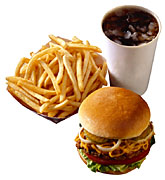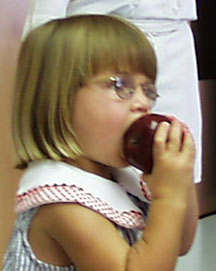
Prepared by
Beth Reames, PhD, LDN, RD,

Diane Linder, EdD, LDN, RD
and

Donna Montgomery, MS
Page 4 of 6
Children sometimes have difficulty
eating enough food at mealtime. Their stomachs are smaller,
and their appetites are likely to change from day to day.
|
|
Snacks
 It's OK for kids to snack and
adults, too, at least sometimes, if the foods they eat help provide
essential nutrients needed for a well-balanced diet. Children
sometimes have difficulty eating enough food at mealtime.
Their stomachs are smaller, and their appetites are likely to
change from day to day. Also, many families do not take
time for three sit-down meals a day. Nutritious snacks
can provide calories and other essential nutrients that may be
missing in a child's diet. It is important, though, that
snack foods fit into the guidelines for a healthy diet low in
fat, sugar and sodium, and provide dietary fiber, vitamins, minerals
and protein. It's OK for kids to snack and
adults, too, at least sometimes, if the foods they eat help provide
essential nutrients needed for a well-balanced diet. Children
sometimes have difficulty eating enough food at mealtime.
Their stomachs are smaller, and their appetites are likely to
change from day to day. Also, many families do not take
time for three sit-down meals a day. Nutritious snacks
can provide calories and other essential nutrients that may be
missing in a child's diet. It is important, though, that
snack foods fit into the guidelines for a healthy diet low in
fat, sugar and sodium, and provide dietary fiber, vitamins, minerals
and protein.
Children sometimes eat too many snacks, especially foods high
in sugar and fat. Then they don't want their meals with
milk, lean meats and poultry, fruits, vegetables and complex
carbohydrates--foods recommended each day in the Food Guide Pyramid.
Risk factors for heart disease often begin in childhood.
Three major ones are related to food habits:
- high levels of blood cholesterol
- high blood pressure
- obesity
 Lack of adequate exercise is another
primary risk factor for heart disease and obesity. Children
snack and watch TV too many hours each day instead of playing. Lack of adequate exercise is another
primary risk factor for heart disease and obesity. Children
snack and watch TV too many hours each day instead of playing.
Eating and exercise habits are learned early in life, and,
once formed, are difficult to change. If children are given
low-fat milk and other nutritious foods low in fat, they will
learn to prefer such foods.
Physicians and scientists from 42 major U.S. health and professional
organizations, including the American Heart Association and the
American Academy of Pediatrics, recently recommended that all
healthy children over the age of two eat a low-fat diet the same
as their parents. It's important to know also that all
health experts unanimously agree that children under two should
not be fed a low-fat or low cholesterol diet. Infants need
the essential fatty acids in full-fat milk or formula for proper
development of brain and body. After age two, low-fat or
skim milk should gradually become part of a healthy, low-fat
diet.
Fast Food
 Fast foods are a major part of
life in America. Most people eat from one to three fast-food
meals a week. More schools are serving fast-food meals
to compete with our preference for fast foods. A steady
diet of fast foods can be a problem for young children.
First of all, they are usually very high in fat and sodium.
And if children develop a taste preference for fast foods, it's
often difficult to get them to eat a greater variety of healthier
foods. Fast foods are a major part of
life in America. Most people eat from one to three fast-food
meals a week. More schools are serving fast-food meals
to compete with our preference for fast foods. A steady
diet of fast foods can be a problem for young children.
First of all, they are usually very high in fat and sodium.
And if children develop a taste preference for fast foods, it's
often difficult to get them to eat a greater variety of healthier
foods.
Most children like fast foods. Most restaurants promote
special meal packages which contain enticing toys. Some
even have playgrounds. So, what's a parent to do?
It's all right for a child to eat a fast-food meal of this type
once in a while. Remember that children want something
even more if they've been told they can't have it! Also,
there really are no good or bad foods. You
just balance those high fat and high sodium foods with lower
fat and lower sodium ones for the next day or two, and increase
the food group choices often missing in a fast-food meal.
But, if you find you're stopping in for a quick meal with
the family several times a week, or driving through to pick up
something to take home, then you may find it's harder to do this
balancing act. That's when it's a good idea to look for
healthier choices.
Tips for making
healthier choices:
- 1. Choose a restaurant that offers more than just fried
foods.
2. Don't ask the kids what they want from the total menu.
Give them a choice, but make it between two or three of the healthier
items.
3. If the kids have to have the special meal package, ask
for substitutions. Ask for juice instead of the cold drink
and a small cup of frozen yogurt instead of the fries.
Or, just get them to put whatever you order in the special container
and offer to pay a little extra for the toy if necessary.
4. Ask how many grams of fat certain items have.
Some restaurants serve milk shakes that have only one or two
grams of fat. Others serve shakes that have 12 or more.
Children over the age of two should limit the number of grams
of fat per day the same as adults. That means less than
30 percent of calories should come from fat, or less than 53
grams of fat a day for a child who takes in about 1600 calories.
5. Order regular hamburgers. They have less than
15 grams of fat and about 250 calories, while double cheeseburgers
can have more than 63 grams of fat and more than 1000 calories!
Fried fish or chicken sandwiches can range from 30 to 40 grams
of fat.
6. A grilled chicken sandwich or salad is fine if you have
them hold the mayonnaise dressing. One tablespoon of mayonnaise
has 11 grams of fat. If you must go with the fried chicken
dinner, then order the breast and remove the skin. Do
without the coleslaw, onion rings or fries. Instead, order
plain mashed potatoes and perhaps the corn, if it's not swimming
in butter.
7. Chicken fajitas, burritos and soft-shell tacos are fairly
good choices. A taco salad is OK if you don't eat the pastry
shell. (With the shell, it adds up to 61 grams of fat and
more than 900 calories!)
8. Pizza can be a healthy choice, especially if you bypass
the meat toppings, order with one-half the cheese and ask for
extra vegetables.
9. Get your kids interested in the salad bar early.
Make upside down salads. Pile the shredded carrots,
green peppers, tomatoes and other veggies on first; add
a little lettuce last. Use low-fat dressings. Stay
away from mayonnaise-based pasta salads or potato salads.
10. Part of a submarine sandwich is a great option, especially
on whole-grain buns. Choose low-fat fillings like lean
roast beef, turkey or chicken. Avoid cold cuts like bologna,
pepperoni or salami and tuna or chicken salads. Ask for
mustard, not mayonnaise.
11. Always insist that the hamburgers are cooked thoroughly
with no pink showing. The center should be gray, the juices
should run clear and the texture should be firm, not mushy.
-
 12. Make sure
your children have plenty of fruits and vegetables at snack time
and other meals if the fast-food meal lacks these items. 12. Make sure
your children have plenty of fruits and vegetables at snack time
and other meals if the fast-food meal lacks these items.
13. For breakfast, pancakes with syrup only, low-fat muffins
or English muffins are wholesome. Most of the breakfast
sandwiches are very high in fat. A fast-food biscuit has
276 calories and 13 grams of fat compared to one you make at
home from a mix. It has only 95 calories and three grams
of fat.
14. Make sure the food you choose for yourself is healthy,
too. Children learn best by example.
   [ LESSONS || SITE
MAP || LOCAL AGENTS || RESOURCES || PEOPLE ]
[ LESSONS || SITE
MAP || LOCAL AGENTS || RESOURCES || PEOPLE ]
 Issued in furtherance of Cooperative Extension
work, Acts of Congress of May 8 and June 30, 1914, in cooperation
with the United States Department of Agriculture. The Louisiana
Cooperative Extension Service provides equal opportunities in
programs and employment. Information and Graphics on this site
are copyright protected by LSU Agricultural Center's Louisiana Cooperative Extension Services.
For more information
on the EFNEP program, contact EFNEPMail@agcenter.lsu.edu. Issued in furtherance of Cooperative Extension
work, Acts of Congress of May 8 and June 30, 1914, in cooperation
with the United States Department of Agriculture. The Louisiana
Cooperative Extension Service provides equal opportunities in
programs and employment. Information and Graphics on this site
are copyright protected by LSU Agricultural Center's Louisiana Cooperative Extension Services.
For more information
on the EFNEP program, contact EFNEPMail@agcenter.lsu.edu.
|